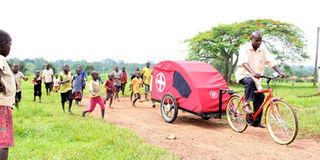Profiting from easing access to medical care in rural Uganda

Children run after a man riding a motorbike-ambulance. Photo BY Didas Kisembo
What you need to know:
Rural ambulance. The weight balanced and low centre of gravity trailer is built to meet the emergency transportation needs of rural communities
Despite advancements in transportation and technology today, many of Uganda’s rural communities still grapple with accessing medical treatment.
However, a social enterprise venture based in Kampala, has partnered with companies and organisations to distribute an innovation that may settle the village ambulance.
From 2012 to March 2014, Pulse Village Transport, a limited liability company, has distributed more than 150 village ambulances in 20 districts in partnership with Non-Governmental Organisations to improve medical care access.
“It is a custom-built, weight balanced and low centre of gravity trailer that can be pulled behind virtually any bicycle or motorcycle and is designed specifically to meet the emergency transportation needs of rural communities,” says Jared White, the Operations director Pulse Uganda.
Birth of idea
The idea was incepted in Africa in 2007, with a company in Zambia called Zambikes.
Back then, his primary goal was to provide affordable, high-quality bicycles specifically designed for African roads but as they interacted with local community leaders, medical professionals, development workers and others, it became acutely apparent that there was a critical need for basic medical transportation solutions in rural Africa.
In 2008, the “Zambulance” (as it is known in Zambia) was created to meet this need and since that time, over 1,300 Zambulances have been distributed in more than five countries across Africa.
In 2012, the Zambulance became available in Uganda and was rebranded as the “Village Ambulance.”
Many rural communities still lack adequate medical transportation and are located far from the nearest medical clinic or hospital. People often resort to slow and unsafe means of transportation such as riding inside a wheelbarrow or oxcart, riding on the back of a bicycle or motorcycle, or being carried many kilometres by family members or neighbours.
“Vehicles are rarely accessible in rural communities due to poor road conditions and poor economic conditions of the community members, ” he explains.
In other instances, expectant mothers have no option but to give birth from home with help from traditional midwives.
These challenges have contributed to poor maternal health and the rising child mortality rates in the rural communities.
“Our village ambulance provides access to safe, easy, and reliable means of medical transportation and is a key link in the chain to preventing unnecessary mortality and disabilities.”
A journey which used to take between two to three hours to reach a rural health centre that was 4km away using a wheelbarrow or stretcher will now take an average of 30 to 40 minutes using a Village Ambulance to cover the same distance.
The ambulance is made with a durable yet lightweight steel frame structure and a pair of durable 17-inch motorcycle tyres to withstand rugged terrains and varying weather conditions. It includes a four-inch thick foam mattress, a hospital certified washable mattress cover, and a weather proof canopy to provide shade and protection from rain and prying eyes.
“Village Ambulances that were placed in Zambia five years ago are still in operation today. Our product is estimated to last seven to 10 years, possibly even longer!” he adds.
In comparison to vehicle ambulances and other ambulances available in the market that go beyond Shs50m, the Pulse Village Ambulance costs Shs3m ($1,200) per ambulance.
“Once the Village Ambulances reach the communities they can set their own prices for usage, often ranging from Shs1,000 to Shs10,000 depending on distance and mode of transport.”
It can safely travel through difficult terrain that even a vehicle would not be able to pass through.




